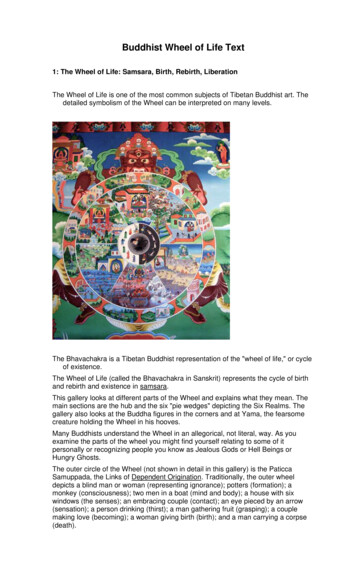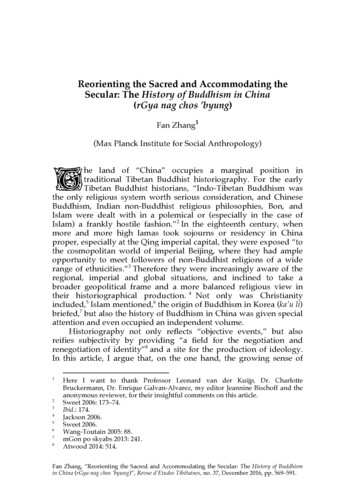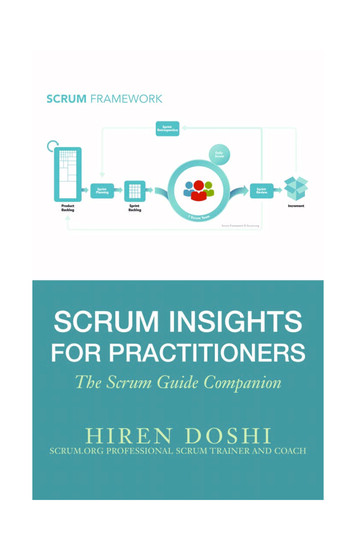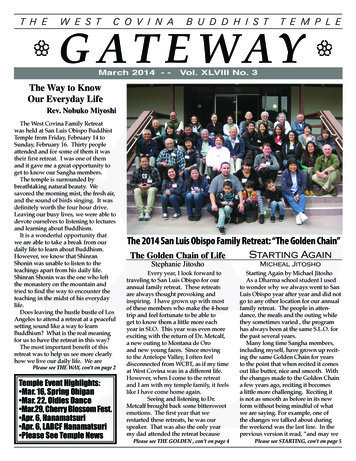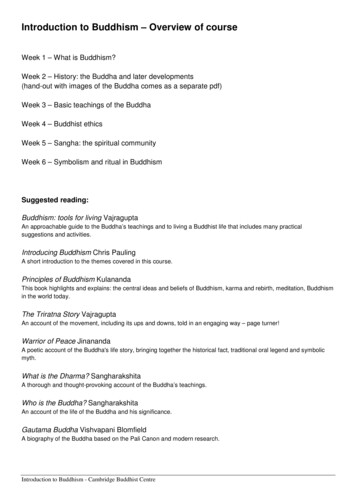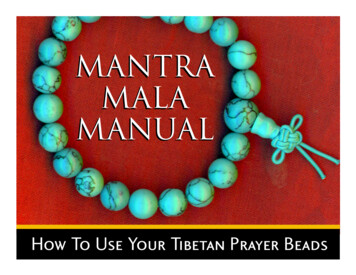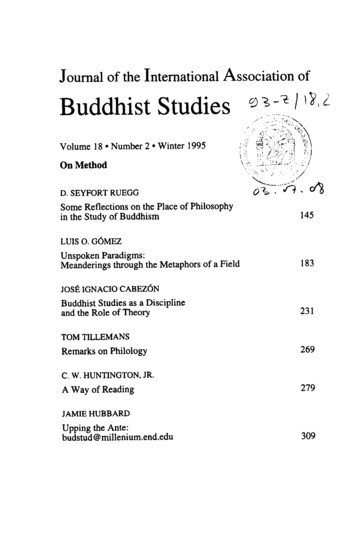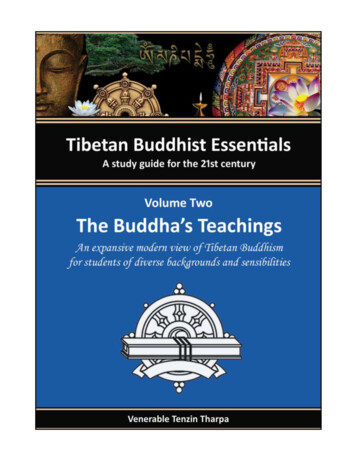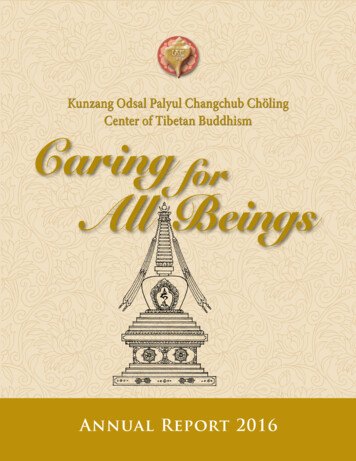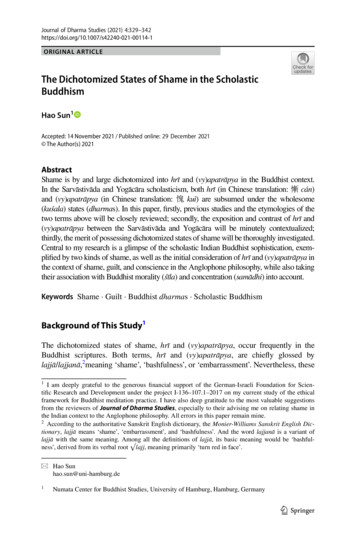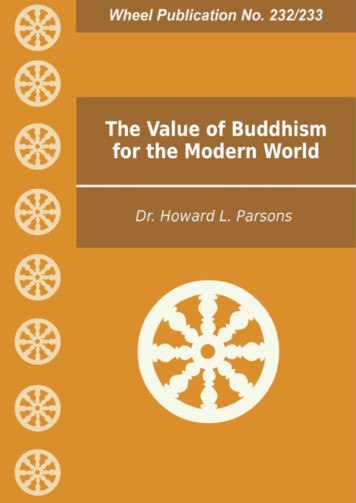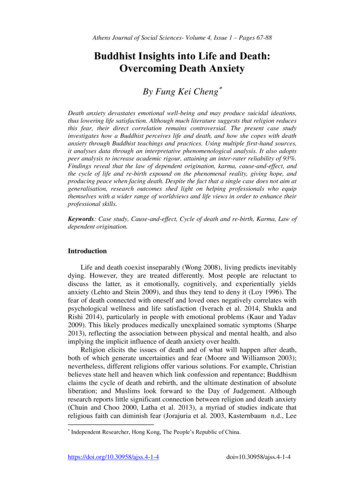
Transcription
Athens Journal of Social Sciences- Volume 4, Issue 1 – Pages 67-88Buddhist Insights into Life and Death:Overcoming Death AnxietyBy Fung Kei Cheng Death anxiety devastates emotional well-being and may produce suicidal ideations,thus lowering life satisfaction. Although much literature suggests that religion reducesthis fear, their direct correlation remains controversial. The present case studyinvestigates how a Buddhist perceives life and death, and how she copes with deathanxiety through Buddhist teachings and practices. Using multiple first-hand sources,it analyses data through an interpretative phenomenological analysis. It also adoptspeer analysis to increase academic rigour, attaining an inter-rater reliability of 93%.Findings reveal that the law of dependent origination, karma, cause-and-effect, andthe cycle of life and re-birth expound on the phenomenal reality, giving hope, andproducing peace when facing death. Despite the fact that a single case does not aim atgeneralisation, research outcomes shed light on helping professionals who equipthemselves with a wider range of worldviews and life views in order to enhance theirprofessional skills.Keywords: Case study, Cause-and-effect, Cycle of death and re-birth, Karma, Law ofdependent origination.IntroductionLife and death coexist inseparably (Wong 2008), living predicts inevitablydying. However, they are treated differently. Most people are reluctant todiscuss the latter, as it emotionally, cognitively, and experientially yieldsanxiety (Lehto and Stein 2009), and thus they tend to deny it (Loy 1996). Thefear of death connected with oneself and loved ones negatively correlates withpsychological wellness and life satisfaction (Iverach et al. 2014, Shukla andRishi 2014), particularly in people with emotional problems (Kaur and Yadav2009). This likely produces medically unexplained somatic symptoms (Sharpe2013), reflecting the association between physical and mental health, and alsoimplying the implicit influence of death anxiety over health.Religion elicits the issues of death and of what will happen after death,both of which generate uncertainties and fear (Moore and Williamson 2003);nevertheless, different religions offer various solutions. For example, Christianbelieves state hell and heaven which link confession and repentance; Buddhismclaims the cycle of death and rebirth, and the ultimate destination of absoluteliberation; and Muslims look forward to the Day of Judgement. Althoughresearch reports little significant connection between religion and death anxiety(Chuin and Choo 2000, Latha et al. 2013), a myriad of studies indicate thatreligious faith can diminish fear (Jorajuria et al. 2003, Kasternbaum n.d., Lee Independent Researcher, Hong Kong, The People’s Republic of China.https://doi.org/10.30958/ajss.4-1-4doi 10.30958/ajss.4-1-4
Vol. 4, No. 1Cheng: Buddhist Insights into Life and Death.et al. 2013, Roshani 2012, Wen 2010), because it gives hope of an afterlife(Soenke et al. 2013), as explained earlier. Dezutter and the research team(2009) conducted a mixed-method study with 471 respondents from 17 to 91years old, among whom 80.9% declared themselves as religious followers.Outcomes showed that religious believers accepted the idea of the afterlifemore likely than non-religious people. However, the attitudes towards deathvaried from age and health status, reflecting a multidimensional model toexamine the relationship of religiosity and death attitude. Professionals ofdeath education may devise programmes to accommodate the needs ofdifferent age groups, in respect of dealing with life and the afterlife. In additionto these findings, Krause (2011) reported the correlation of religious meaningin life and death anxiety among older adults, influencing their psychologicalwell-being. Thus, this proposed an enhancement in measuring religiousmeaning in life in a more comprehensive perspective. Such psychometricinstrument will give references to scholars and practitioners who serve theelderly to take care of spiritual wellness in their late stage of life. Religiouscoping can reduce such stress, as elaborated on previously, for whichBuddhism offers alternative views, enabling an individual to cope with thisdread more comfortably (McCormick 2013) caused by Buddhist views ofworld and life which will be illuminated by the participant of this research.Developed by the Buddha over 2,500 years ago in India, Buddhism helpshuman beings alleviate suffering, especially for psychological afflictions, forwhich the Buddha preached for 49 years and demonstrated how he couldachieve liberation from tribulations. Buddhism provides people with a set ofpractices to handle life difficulties (Cheng 2015c), including a variety ofmeditation. After his death, Buddhism has evolved three mainstreams:Theravāda, Mahāyāna, and Vajrayāna (Tantric Buddhism). Theravāda paysstrong attention to personal achievements for extinguishing suffering, that is,nibbāna (perfect stillness). Rooted in the fundamental theories, Mahāyāna andVajrayāna are comparatively committed to altruistic behaviour (Cheng 2015a,Cheng 2015b, Cheng 2015d). Regardless of the diverse focal tenets of thesetraditions, they share a common consent about the transcendence of death.For Buddhists, life is considered to be not only a process (Bernhard 2010),but more importantly a "vast process of becoming" (Corbett-Hemeyer 2005:8140) with an unceasing cycle of living and dying, implying that individualsexperience death innumerable times, either in the past or in the future (Keown2005). It is also a "psycho-physical combination" (Gunaratna 2001: 9) in whichhappiness and inevitable suffering react and interact within this cycle, which isneutral in nature and is not associated with either positive or negative premises(Rahula 2001). Optimistic or pessimistic reactions depend on individualperception. Optimistic people consider that felicity and distress enrich theirlives; in contrast, pessimistic people worry about the loss of joy and thepresence of misery, because of which they produce anxiety and unease.Depending on the individual response to reality, it becomes possible totranscend suffering (Mizuno 2003) and subdue death anxiety, when a personsuccessfully searches for meaning in life (Frankl 1946/2006) and subsequently68
Athens Journal of Social SciencesJanuary 2017prepares to die well through letting go of death (Byock 1996). This manifestsan invaluable "sanctity of life" (Perett 1996: 310). These hint at palliative carepractitioners who can serve their clients and family members at a peacefulmanner and may enable clients to face death calmly; hence, there is a growingtrend of using Buddhist concepts in clinical fields (Kawamura 2000), as aBuddhist-based care approach (Tung 2010).In spite of a fact that a substantial body of literature elucidates theBuddhist philosophy of death, limited research offers personal narratives ofBuddhist attitudes towards death. The present qualitative research exploreshow Buddhism views living and dying, and how a Buddhist tackles deathanxiety; from which researchers and practitioners who serve patients withterminal illnesses and their family caregivers may gain insight into carrying outtheir professionalism with alternative perspectives. It also details the researchmethods by multiple data sources, analyses the lived experience of theparticipants, and discusses implications of the findings.Research DesignThis study has been approved by the Human Research Ethics Committeefor Non-Clinical Faculties, The University of Hong Kong. It posted anelectronic advertisement through contact lists provided by an academicdepartment. The selection criteria included: first, informants were over 18years old; second, informants were Buddhists, regardless of Buddhist sects ordenominations; and third, informants were emotionally stable to discuss death.Potential informants were invited to an initial meeting to have a fullunderstanding of the research objectives and procedures. One participant wassuccessfully recruited and signed an informed consent; because of which thisproject used a case study.A case study is an empirical inquiry from which it examines a real-lifephenomenon and provides first-hand, in-depth data to professionals for furtherexploration (Yin 2009), even though the number of cases is as small as a singlecase. The strengths of this qualitative method include a revelatoryunderstanding of a specific phenomenon, a gain of insights from personalaccounts of participants and an extension of investigative dimensions. Inparticular, a single case study potentially attains distinctive, unique, andstrategic importance related to the general problem (Bramley and Eatough2005, Flyvbjerg 2006), benefiting the theory-building process.In using a single case study, insightful ideas are presented through thelived experience of the chosen participant (Yin 2009). In addition to face-toface, individual, in-depth, semi-structured interviews (totally two sessions, 148minutes), art making (Figures 3 and 4) was employed in this project to enrichthe collected data. The interviews were recorded digitally and transcribed. Theverbatim transcriptions were analysed by employing an interpretativephenomenological analysis with the aid of ATLAS.ti 7 (Figure 1), a softwarefor managing qualitative data.69
Vol. 4, No. 1Cheng: Buddhist Insights into Life and Death.An interpretative phenomenological analysis, focusing on the existentialphenomenological lens (Shinebourne 2011), is specifically suited to a casestudy which looks into an individual’s subjective perception, sense of self,inner world, psychological reactions, and meaning in life (Bramley andEatough 2005, Eatough and Smith 2006, Shinebourne and Smith 2009),without prior hypothesis or previous findings (Nithsdale et al. 2008). Thisapproach emphasises the interaction between the researched and the researcherto minimise interpretation bias (Roncaglia 2010, Smith 1996) and optimise aholistic understanding of the participant.In order to enhance research rigour, member-checking was adopted. Thetranscription was proofread by the participant to ensure the accuracy, which isimportant for appropriate data analysis. An analysis map (Figure 2) was thendiscussed with the participant in order to secure proper interpretation.Furthermore, a co-analyst was invited, who conducted separate coding from theprincipal analyst (the author). The principal analyst subsequently compared thetwo sets of coding, and developed the two super-ordinate themes and emergentthemes (which will be exhibited in the following sections). This peer analysisachieved an inter-rater reliability of 93%, which signifies a high level ofanalysis objectivity.Figure 1. Qualitative Data Analysed with the Aid of ATLAS.ti 7Source: Author.70
Athens Journal of Social SciencesJanuary 2017Figure 2. Analysis MapSource: AuthorBuddhist Insights into Life and DeathDawn, a single middle-aged social worker and pious Buddhist, focuses onTheravāda (a denomination of Buddhism) in order to attain nibbāna for theultimate liberation. She serves the elderly and patients with terminal illness inSingapore, because of which she frequently faces the suffering, vulnerabilities,and death of her clients, which triggers emotional fluctuation in her. Of note,Buddhist teachings and practices enable her to soothe tension and preventcompassion fatigue (Cheng 2014b), since Buddhism emphasises mind training(Smith-Stoner 2005) to conquer life’s difficulties.By analysing Dawn’s data sharing, this research achieved two "superordinate themes" (Smith et al. 2009: 96) – first, principal Buddhist teachingswhich Dawn experienced; and second, interpretation of life and death – toexpress her strategies for managing death anxiety.Principal Buddhist Teachings Which Dawn ExperiencedBuddhism explains the formation of existence under the law of dependentorigination, denoting interdependence and connectivity among all beings71
Vol. 4, No. 1Cheng: Buddhist Insights into Life and Death.(Epstein 2005). Buddhists conceive that nothing exists without the properinteraction of an aggregate of primary and supplementary causes (orconditions). For example, a seed is a main cause which needs the support ofsoil, water, and air to grow into a healthy plant. However, these conditionschange frequently, with polluted water, for instance, which displaysimpermanence and an insubstantial nature (Conze 1953, Gethin 1998). Suchuncertainties, transience, and temporalities reflect not only phenomenal realitybut also an ever-changing self (Bruce 2007, Moreman 2008) in the sense ofphysical and mental domains (Watson 1998), due to internal and externalfactors, such as with the degeneration of body or changes of the mind.Moreover, the human body is a complex grouping of sensations, pertaining toseeing, hearing, smelling, tasting, and touching; which all affect the emotions.These sensory capabilities gradually decay, and emotional reactions change.This generates misunderstandings, particularly in people with dementia.This theory (the law of dependent origination) provides Dawn with apositive worldview, rather than a pessimistic one, because she could perceivethe open phenomenal system (Welwood 2003) and reduce the intensity of herself-centredness (Epstein 1999), which led her to experience the presentmoment, delineating that:"I always remind myself not to adhere to my plan rigidly. I cangradually become more detached because life is uncontrollable; forinstance, sudden death, sudden sickness, and failure. I can’t control manythings. I can’t plan too much. Change is faster than planning. [Therefore,it’s] too difficult to plan. But I remind myself everyday: I must treasureevery minute and every second, and I have to lead my life. This means thatI must try my utmost everyday [for everything]."In addition, she applied her positive attitude towards vicissitudes toemotional management, as she understood the transposition of happiness anddistress, from which she learned to accept impermanence and let go ofmisfortunes more easily, repeating as follows:"Life contains unhappiness and happiness. But all these will pass on. Offering flowers to the Buddha (a Buddhist ritual) aims to remind us of thefact that [beautiful] flowers will wither, just like the fact that everythingwill fade out and everything will vanish. There is no permanence. Thistells us that all things will go away, whether good and bad. [I] accept theunhappiness at that moment [when I was] unhappy [because I know thatthe unhappiness] will go away. I feel happy [and I know that] this momentwill also go away. "Despite the fact that individuals are always non-autonomous andpowerless, they are able to create favourable conditions which result in aparticular cause-and-effect: karmic effects (Keown 2000) that are caused byprevious behaviour (Soothill 1913, Thubten 2008) in one’s present and past72
Athens Journal of Social SciencesJanuary 2017lives. Good actions produce appreciative feedback and poor behaviourengenders unfavourable fruit (Craig et al. 2010, Zopa 2012), which urgespeople to behave carefully and take responsibility for what they do (Conze1967), inviting them to calmly accept the reality (Kain 2013) that is reflected intheir inescapable karmic life (Keown n.d.). Dawn serenely described the peoplewho treated her badly:"My [ex-]boss is biased against me. I don’t know why somebody Presently, I believe this is karma that has been brought forward from [my]previous lives. I must have had problems with him in previous lives.Therefore, he doesn’t like me. He often compared me with my colleagues.He would give them opportunities and promote them. He would[always] complain about me harshly. In fact, any relationships linked toprevious relationships – unfinished business in a past life that carriesforward to this life. [Those people who dislike me] must have had[poor] relationships with me in my last life."However, these frustrations did not weaken Dawn; instead, she gave uphatred in order to create good karma. She willingly forgave those who hurt her,which enabled her to realise compassion and self-compassion. Thiscompassion-based approach improved her emotional regulation and selfdiscovery of inner resources. She elucidated that:"The most important issue is the continued self-compassion andcompassion towards other people. I’m very open. I forgive what I canforgive. This benefits me. [Meanwhile] I fight for what I should fight for.But if I’m unable to fight for it, I’ll take it easy. I won’t tangle with others. I won’t blame them (those who bully me) because they are ignorant[about the phenomenal reality]. But I’m also too ignorant to be qualified toblame them."In learning Buddhism, Dawn enhanced her self-reflection, knowing herweaknesses and strengths, which also increased her self-awareness andtranquillity. All these caused her to be more humble, so that she amelioratedher intra- and interpersonal relationships, as she confessed:"The brightest insight I have gained from Buddhism is to know how subtleI am. Therefore, I become more humble, more humble. When I haveproblems, I perceive them positively. I’ll complain less. I take care ofmy family more after learning Buddhism. "The concepts of life and death in Buddhism present its core teachings onthe law of dependent origination, impermanence, karma, cause-and-effect, andthe cycle of death and re-birth (Black and Rubinstein 2013, Long 1975,Stonington 2011), revealing a distinct attitude towards death (Schafer 2007).Buddhists recognise that greed for protean life and resistance to unavoidable73
Vol. 4, No. 1Cheng: Buddhist Insights into Life and Death.death produce suffering, by which understanding Dawn pursues a rich life andhopes to reach "the other shore".Interpretation of Life and DeathThe set of Buddhist tenets gives Dawn room for personal interpretation oflife and death. Such interpretation not only depicts the dynamic between lifeand the afterlife, but also highlights how she prepares for good death within herlife.Rich LifeA higher happiness level dissipates fear of death (Ziapour et al. 2014), butlife is full of both joy and suffering (Janning 2014). Dawn focused on thebeauty of life, consisting of water, sun, trees, flowers, and birds, each of whichrepresents a complicated mixture of her belief and emotional states. Shearticulated her ideas through a drawing (Figure 3):" a tap, running tap water because water represents life. There iswater, and then is the sun. When there is the sun, there is a smile. Why?Because the sun shining all over the world gives hope. After drawing thesun, I draw trees. The fruit on the trees stands for life. Then [I] drawflowers (sunflowers), and grass. Then [I draw] birds. They alsorepresent life. a pair, a pair All these represent life. My life isn’tcolourful. It’s not smooth. I have many down moments. I chooseseveral [crayon] colours. Perhaps, this implies my underlying hope for acolourful life. [I believe life] comprises different things. Maybe,matching various things completes a fuller life."Figure 3. Rich LifeSource: Cheng 2014a: 178.74
Athens Journal of Social SciencesJanuary 2017Her perception and hope towards life extend to her understandings ofdeath and the afterlife, her life style resonating with Buddhist practices such asmeditation that will be delineated in a later section.The Other ShoreDeath is a natural process, as Buddhism relates (Bowman and Richard2003); thus, Buddhists are poised to face demise (Chan et al. 2011), as detailedby Dawn, who improved her mortality salience (Ma-Kellams and Blascovich2012):"My father and mother are getting old. They’ll leave us sooner or later. [I]have gradually accepted this fact. I remind myself of such facts.Previously, I was [always] very nervous. When my father was in thehospital, I was very nervous. To me, he was already old. His clothes (hisbody) are already old. He’ll leave these clothes sooner or later. I alreadyunderstand this. I [also] prepare for myself (my death)."This interpretation of death pertains to two dimensions, although deathdoes not necessarily mean death (Desjarlais 2000). On the one hand, life isendless and implicitly involves death and re-birth (Metzner 1996, Ratanakul2004), representing recurrence of suffering in the human world (Masel et al.2010). On the other hand, Buddhists strive for liberation (Piven 2003), that is,the ultimate dissolution of the cycle of life and death. The termination of thiscycle extends past the afterlife (Hasker 2005). It converts the physical bodyinto a "transcendent body" (Bernstein 2012: 275), resulting from thetranscendence of craving (Florida 1991), by bringing suffering forward to theother shore (Whitehill 1994), which stands for a desirable output. Dawndelineated her idea of the other shore (Figure 4) as follows:"I drew a river. It’s a boundary. Reaching here is the other shore. Because here implies brightness. Reaching the other shore is full of hope. I learned Buddhism and changed my concept of death. The other shoreis full of hope. Death does not necessarily mean darkness. Perhaps, [I] canreach the other shore after death. "75
Vol. 4, No. 1Cheng: Buddhist Insights into Life and Death.Figure 4. The Other ShoreSource: Cheng and Tse 2014: 6.Aiming to reach the other shore, Dawn practised meditation foremancipation, stating:"[When I draw this picture,] I add a person practising meditation. Meditation is an important way to go to the other shore, I believe. [I]know there is an other shore. Meditation is a method [to attain it].Therefore, I continue my meditation. "Meditation or mindfulness has been popularly adopted for therapeuticpurposes, as a choice of integrative medicine (Williams-Orlando 2012), orcomplementary and alternative medicine (Barnett and Shale 2012, Cuellar2008), with positive indicators (Baer 2003, Brown and Ryan 2003, Teasdale etal. 1995) over a wide spectrum of physical and mental illnesses, includingcancer survivors (Birnie et al. 2010, Bränström et al. 2010, Johnston 2012,Thornton et al. 2014), chronic pain (Grant and Rainville 2009, Kabat-Zinn1982, McCracken and Vowles 2014), depression and anxiety (Anderson et al.1999, Liehr and Diaz 2010, Williams et al. 2014), panic disorder (Kim et al.2010), eating disorders (Godsey 2013, Kristeller et al. 2014), obsessivecompulsive disorder (Hertenstein et al. 2012), posttraumatic stress disorder76
Athens Journal of Social SciencesJanuary 2017(Barnes et al. 2013, Seppala et al. 2014), family and couple relationships(Beckerman and Sarracco 2011, Cohen-Katz 2004, Duncan et al. 2009, Gehart,2012), professional burnout (Cohen-Katz et al. 2005, Vilardaga et al. 2012,Zeller and Levin 2013), attention deficit hyperactive disorders (Carboni et al.2013, Haydicky et al. 2012), and developmental disabilities (Hastings andManikam 2013, Hwang and Kearney 2014).From among various meditation approaches, Dawn practises insightmeditation (Pali: vipassanā), which cultivates wisdom (Disayavanish andDisayavanish 2007), and enables her to achieve a balanced mind and insightinto the phenomenal reality, resulting in accomplishments in genuine happiness(Ekman et al. 2005) and quality of life (Taniguchi, n.d.). Through thispurification process, she gained spiritual freedom, acclaiming that:"[I] surrender what I don’t need, what tightens me, what affects mypractices, and particularly my attachments. This is liberation. [When I]give up these, [I can] forgive those [who treat me badly]. Because I canreduce self-centredness. I know more about myself. I know why I wasunhappy. When I meditate, I have the feeling that if I don’t attach somuch and if I can become more open, I’ll be happy."Apart from her increased self-awareness that, "when I cry, I’m mindful. Iknow why I’m crying", equally as important, is that she prepares for a peacefuldeath with a pacified mind (Kongsuwan et al. 2010b, Smith-Stoner 2006)through such disciplined mind training.Non-Duality between Life and DeathThe current case study reveals that spiritual care is essential for peacefuldying (Kongsuwan and Touhy 2009). Buddhism construes an endlesscontinuum of living and dying from two dimensions. The cycle of death and rebirth as affected by karma places an emphasis on life, urging virtue and moralbehaviour (Lin and Yen 2015). Virtuous behaviour not only raises a good lifebut also deliberately brings forward a good afterlife, ultimately referring toliberation. When death causes re-birth, death is necessary for a new life.Limitless re-births create infinite life and death, which generates suffering fromloss and attachment. In such cases, life and death are not antithetic butsymbiotic. Likewise, a good life and good afterlife has become a pair of twins,denoting that life and afterlife have no differences per se. Life is a practice inthe secular world and afterlife is a practice on the other shore. Death links upwith life, afterlife, re-birth and liberation, indicating that life and death are notantagonistic but are simply varied forms of representation. All these not onlydiscourage death denial but also transcend death anxiety (Chaiwutikornwanich2014).Buddhism also enunciates the non-dualism of life and death by raising theconcept of an "empirical self" (Burns 2003: 93), namely, a phenomenal self. In77
Vol. 4, No. 1Cheng: Buddhist Insights into Life and Death.light of the law of dependent origination, all living beings are manifestations ofphenomena. The physical body is a manifestation of life; so death is of theafterlife. As such, manifestations are insubstantial, volatile and transient, whichreflects the nature of life and death. This deconstructs the polarisation betweenliving and dying (Loy 1990, 2000), and conflates the "dichotomy betweenbeing and non-being" (Loy 1992: 153), dissolving the feeling of loss (Loy2002). With minimal unpleasant emotions, Buddhists can accept deathtranquilly (Kongsuwan et al. 2010a), so that they can resolve grief andbereavement more easily (Goss and Klass 1997).ImplicationsFindings reveal practical implications to therapeutic practitioners,including non-judgemental communication, religious-based communication,and mindfulness training. These techniques can relax the tensions of clientswho suffer from mental distress, such as death anxiety. Notwithstanding,limitations of this study and directions for future research are also presented.Shared experiences from a group of hospice volunteers ascertain thesignificance for companionship and listening without judgement for hospiceservice (Baugher 2008), which aligns with the Buddhist non-judgementalnotion. Non-dualism removes the two extremes, for example, life and death,realising non-judgement. Dawn appreciates both life and afterlife, and strivesto attain well-being in the present and future lives. Hence, palliative careworkers listen to the clients non-judgementally and respectfully, disregardingworkers’ religious orientations. Such non-judgemental listening will result inmutual trust, truly companionship and hearty communication, which are theforemost qualities of serving end-of-life clients.Communication, particularly verbal expression, forms a vital part intherapeutic settings (Kourkouta and Papathanasiou 2014), in which serviceproviders echo with service recipients when they communicate through thesame language. In a religious-based platform, same language refers todogmatic terminology; for instance, karma, the cycle of death and rebirth, andimpermanence in Buddhism. Using religious terms touches clients’ innerfeelings and grasps their core values of life, because of which the therapeuticrapport and engagement will be built more skilfully in spiritual, transpersonalcommunication (Sherko et al. 2013). Therefore, death-related service providersare able to flexibly deal with clients with different religions if they receivetraining associated with greater diversity of religious knowledge.Mindfulness/meditation is an important practice across various Buddhisttraditions, which instils calmness and a peaceful mind (Kabat-Zinn 2009). Thistranquillity fosters self-awareness (Bruce and Davies 2005), self-acceptance(Carson 2006), self-compassion (Hoge et al. 2013, Raab 2014), non-dualisticviews (Gill et al. 2015), and forgiveness (Webb et al. 2013) due to a complexof neurophysiological mechanisms (Jerath et al. 2012, Vago and Silbersweig2012). These internal resources positively correlate with physical health78
Athens Journal of Social SciencesJanuary 2017(Lawler et al. 2005) and psychological well-being (Germer and Neff 2013,Krause and Ellison 2003, Palos and Vîscu 2014). Thus, mindfulness training isproposed to death-related service practitioners (Cacciatore et al. 2015) (forexample, grief and bereavement, palliative and hospice care) and their clientsin order to empower themselves to enhance mental wellness. Notably,mindfulness can be assimilated into daily activities (Kabat-Zinn 2005, Keuneand Forintos 2010, Tart 1990) to achieve long-term effectiveness. Since thepractice of mindfulness/meditation cultivates bare attention, contemplation,clear comprehension, and a sense of present awareness (Bodhi 2011), it can beapplied to mindful eating, walking, sleeping, gardening, and sport (Cheng2015c) to optimise its effects. This can be applied to non-Buddhist clients andpractitioners to enrich mental wellness, including a reduction in death anxiety.In spite of potential applications elicited by the outcomes of this project, asdiscussed earlier, there are two limitations. In the first place, even though thissingle case study reveals how a Buddhist perceives life and death supported byBuddhist philosophy, it does not intend to make a generalisation, as casestudies focus on exploring scenarios in an in-depth fashion rather thangeneralising phenomena (Thomas 2011). Research on this topic with a largersam
Overcoming Death Anxiety By Fung Kei Cheng Death anxiety devastates emotional well-being and may produce suicidal ideations, thus lowering life satisfaction. Although much literature suggests that religion reduces this fear
